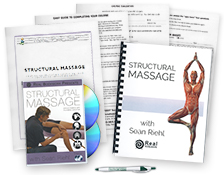7 Hour CE Course

Massage therapists don't often conduct a full-body, range of motion assessment because there are so many types of tests that it becomes daunting! Sean Riehl breaks it down into an easy assessment that you can do with every client. Your clients will love this work because they can see where they are stuck and when you retest at the end of the session they can see how much your work has helped.
The demonstrations in this course begin with a range of motion, full-body assessment, testing each joint’s motion in each direction. Once a restriction is discovered you’ll learn four techniques for increasing range and decreasing pain.
What will be covered in the course:
The course allows you to master body evaluation and experience a high degree of clinical mastery with incredible outcomes.
Challenging enough to be engaging, yet simple and enjoyable as well. Overall, I truly enjoyed the video. The training video and text are very thorough and useful. Very well presented!Brooke Fiske, RMT
Great course! I will definitely utilize these testing and assessment tools more often. I had forgotten many of these that we learned in school, and learned a few that I didn't learn.Jennifer Grant, ABMP
I thoroughly enjoyed this course and plan to implement ROM evaluation and concepts/techniques presented in this course. The course gave me more confidence in my abilities as a therapist and I plan to take more courses presented by Sean Riehl. His presentation was clear, concise, easy to follow and comprehend.Evalani Manzon, LMT
Love having a video along w/ the written manual for the course.Dianne Jezak, LMT
This was the worst class I've taken from here. The info was confusing and the test answers were wishy washy. Very difficult to go back and find answers or understand information. Great subject but the way it was presented was confusing. I've never had this difficulty before.Jennie Finnigan, LMT


Take our free online course: Ethics Refresher
We will not rent/sell your email to anyone.
You'll also receive our newsletter and special offers.
Thank you! An email will be sent to the address provided with instructions on how to enroll in this 1 CE hour course - FREE!
If you do not see our email within a few minutes of signing up, please check your Spam/Junk folders it may have been delivered there instead of your inbox.
If, by chance, you still have not received it within 5 minutes, please call us at 1-800-364-5722, Monday-Friday, 9am-5pm EST for assistance.